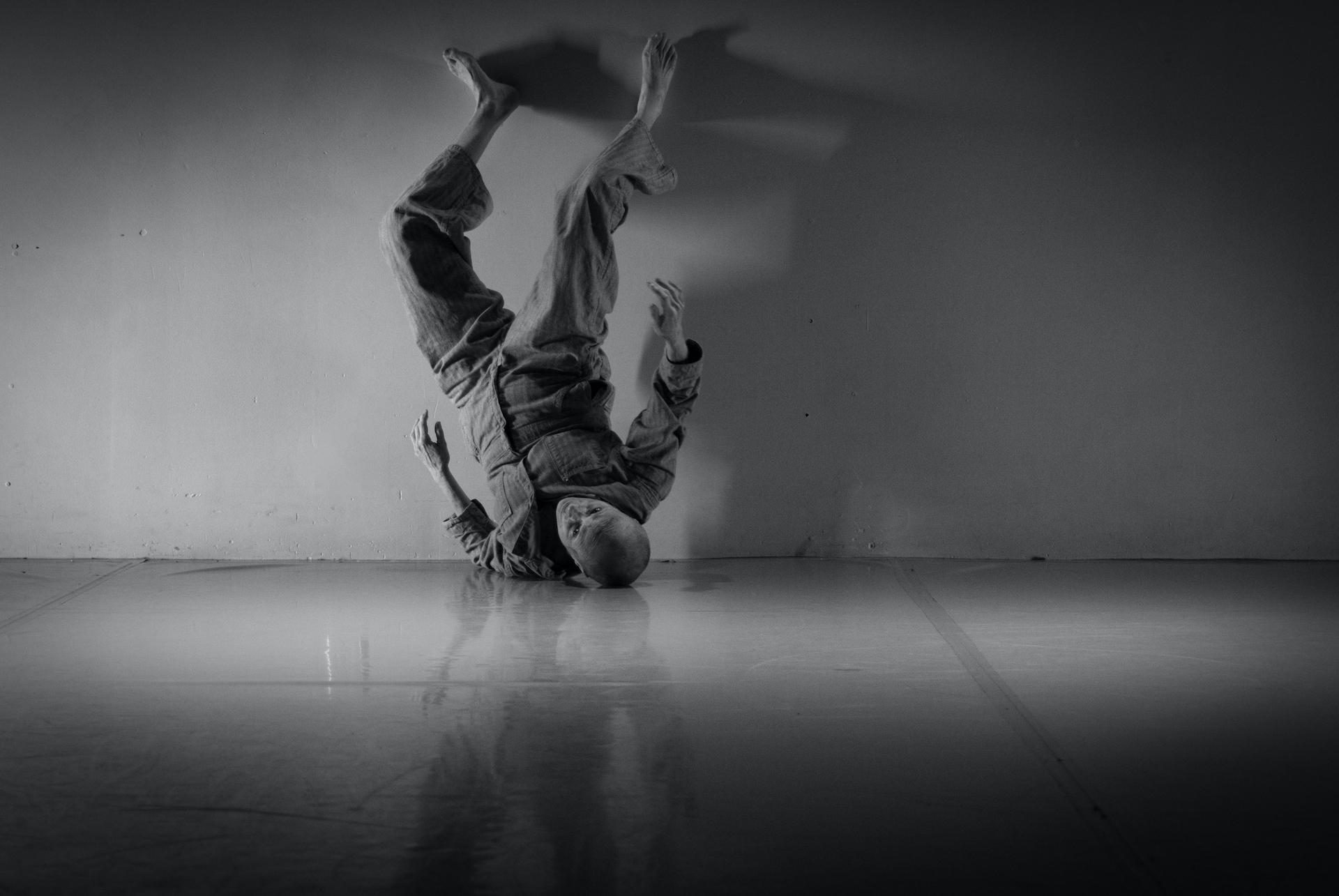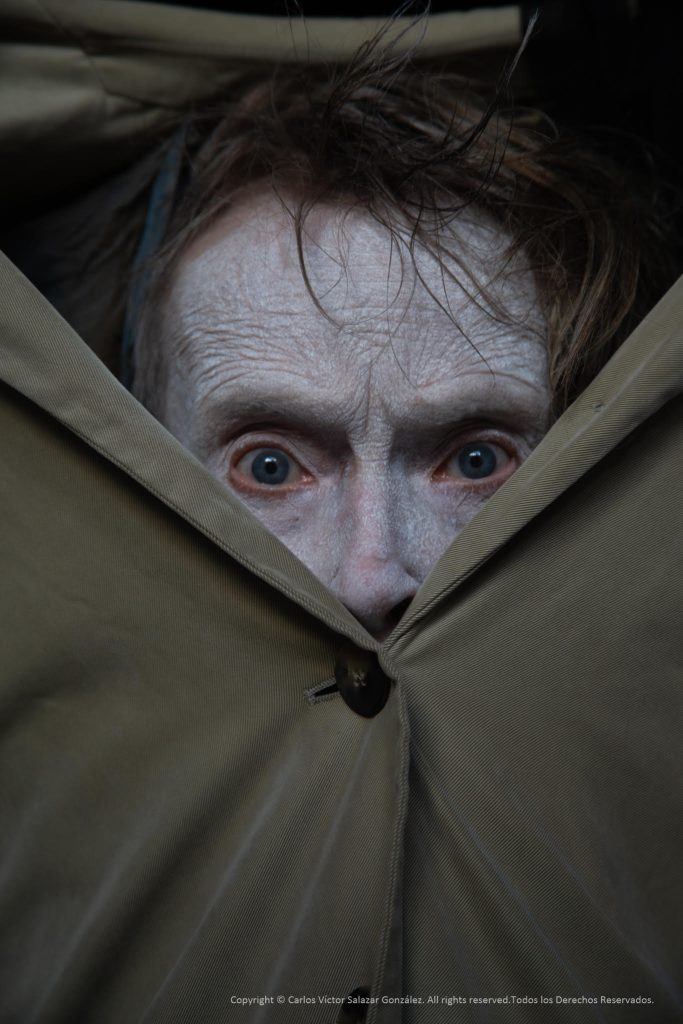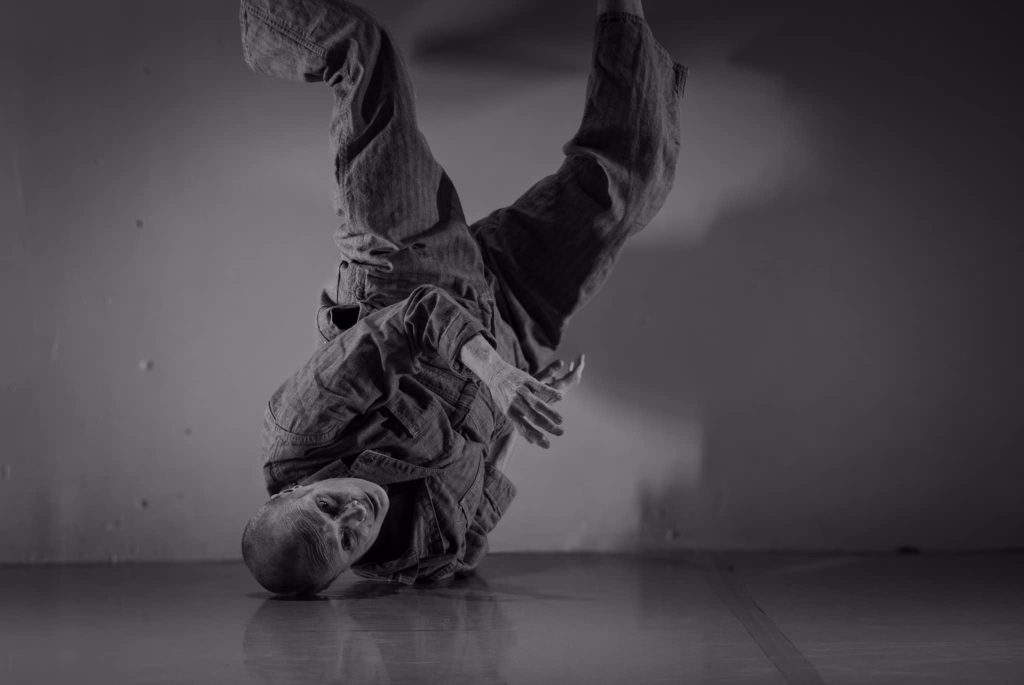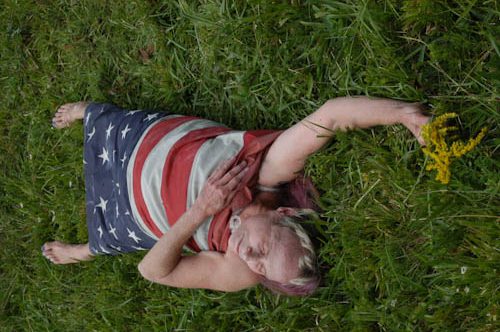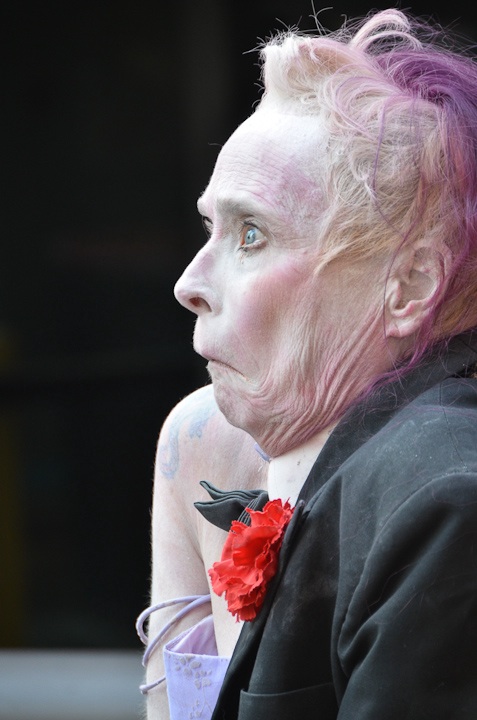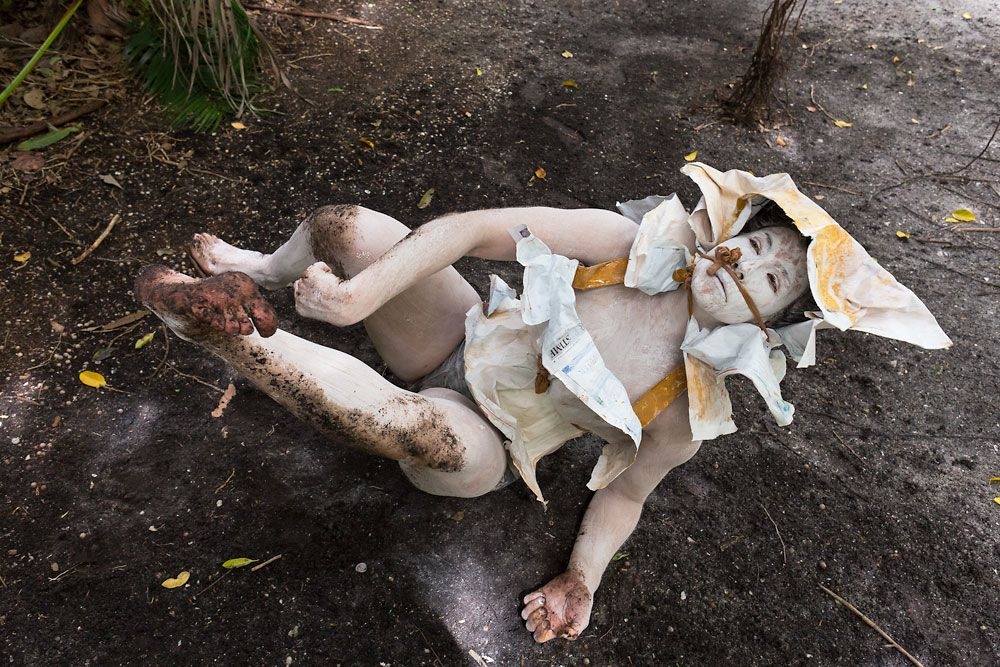FORCES
“There is an entire universe inside my body,” said Kazuo Ohno.
For a choreographer, the body is the primary instrument for artistic research and expression.
The perfect butoh body is an empty container to be filled and moved by forces, conditions, and imagination. What if everything inside and outside of the body were an active force? These forces work on macro- and micro-cosmic levels, shifting balance, intention, and anatomy. Some forces work together, coordinating to generate movement. For example, the endocrine system interacts with the gastrointestinal system to control digestion and metabolism. Other forces vie for control over the human vessel. An autoimmune disorder occurs when a person’s immune system mistakenly attacks their body. There are around 80 different autoimmune disorders ranging in severity from mild to disabling, depending on which body system is under attack and to what degree.
Ohno’s prescription for universal awareness opens doors to elemental concepts of physics, biology, psychology, evolution, and all parts of the great cosmos, including mundane existence. After extensive intellectual and physical research learning everything there is to know about any subject, “Forget it all,” as Tatsumi Hijikata says, and find the immediate visceral connection to the essence of glacier, tree, wind, worm, or bird. Dancers must respond to multiple levels of information, from alterations in the space-time continuum to inward research involving intuition, sensations, and memories of evolution. Therefore expansive awareness of body, mind, and feelings is necessary during performance.
Physicists define four fundamental forces in nature: Strong Nuclear, Electromagnetic, Weak Nuclear, and Gravity (from strongest to weakest). The strong and weak nuclear forces are responsible for subatomic interactions between particles. Electrical charges produce magnetic fields which affect space and time. Gravity acts between masses to alter the shape of space-time into a curve. Despite being the weakest force, gravity works across infinite distances, making it responsible for the universe’s structure.
Of the four atomic interactions, gravity is the most physically felt and interacted with by humans daily. Gravitation was the first interaction to be described mathematically. In ancient times, Aristotle hypothesized that objects of different masses fall at different rates. During the Scientific Revolution, Galileo Galilei experimentally determined that all objects accelerate toward the Earth at the same rate. Isaac Newton’s law of Universal Gravitation (1687) was a good approximation of its behavior. Albert Einstein’s General Theory of Relativity of 1915 is a more accurate description of gravitation in terms of spacetime geometry.
From birth, we learn to work with gravity. When we fall out of the sac that housed us for 9 months as a lump of flesh with soft, flexible bones, we are glued like squishy mud to the earth. Gradually, we dry out and our form distinguishes itself. We lift our heads and arms, caress our feet, our eyes see beyond, and we feel the urge to explore. We roll over, push our bellies away from the earth, and crawl. We build strength and learn to stand and walk. Walking combines falling and pushing away or recovering from the fall. As dancers, we break down and develop the different parts of the walk starting very slowly, feeling the simple weight shift from one foot to the other. How does the body react to the weight shifts and the relationship to gravity?
Gravitation is by far the weakest of the four interactions at the atomic level, where electromagnetic interactions dominate. Gravity is relevant for large mass, planet-sized objects and over expansive distances for several reasons.
- It is the only interaction that acts on all particles having mass, energy, and momentum
- It has an infinite range, like electromagnetism but unlike strong and weak nuclear interactions
- It cannot be absorbed, transformed, or shielded against
- It always attracts and never repels
Even though electromagnetism is far stronger than gravitation, electrostatic attraction is not relevant for large celestial bodies, such as planets, stars, and galaxies, because these bodies contain equal numbers of protons and electrons and so have a net electric charge of zero. Nothing “cancels” gravity, since it is only attractive, unlike electric forces which can be attractive or repulsive. On the other hand, all objects having mass are subject to the gravitational force, which only attracts. Therefore, only gravitation matters in the large-scale structure of the universe.
The long range of gravitation makes it responsible for such wide-ranging phenomena as the structure of galaxies and black holes; it retards the expansion of the universe. Gravitation also explains astronomical phenomena on more modest scales, such as planetary orbits, and everyday experience: objects fall; heavy objects act as if glued to the ground, and animals and people can only jump so high.
A 3.7-billion-year-old record of our planet’s ancient magnetism has been unearthed, providing evidence that Earth’s magnetic field already existed very early in history. This discovery, however, is quite surprising. Previously, estimates and hints of the early Earth’s magnetic field have come from individual mineral crystals called zircons found within ancient rocks from Western Australia. These had suggested the existence of a magnetic field 4.2 billion years ago. However, those results were subsequently doubted as unreliable.
The new results from the Greenland rocks are considered more reliable because, for the first time, they are based on massive iron-bearing rocks (rather than individual mineral crystals) to derive the primordial field strength. Therefore, the sample offers the first solid measure of not only the strength of Earth’s ancient magnetic field but also of the timing of when the magnetic field originally appeared.
The ancient magnetic field perhaps protected the earth during the creation of early life forms shielding them from solar winds and cosmic radiation emitted by the sun. This system helped to form the primordial sea that acted as an incubator of life. Perhaps it was designed by the driving force of DNA to preserve and enhance the evolution of life in any form.
The weak force is critical for the nuclear fusion reactions that power the sun and produce the energy needed for most life forms here on Earth. It’s also why archaeologists can use carbon-14 to date ancient bone, wood, and other formerly living artifacts. Carbon-14 has six protons and eight neutrons; one neutron decays into a proton to make nitrogen-14, which has seven protons and seven neutrons. This decay happens at a predictable rate, allowing scientists to determine how old such artifacts are.
The strong nuclear force, or interaction, is the most complicated of the fundamental forces, mainly because of its variability with distance. The strong nuclear interaction is the strongest of the four fundamental forces of nature. It binds the elemental particles of matter together to form larger particles. It holds together the quarks that make up protons and neutrons, and part of the strong force also keeps the protons and neutrons of an atom’s nucleus together.
Much like the weak force, the strong force operates only when subatomic particles are extremely close to one another. The strong force behaves oddly, though, because unlike any of the other fundamental forces, it gets weaker as subatomic particles move closer. It reaches maximum strength when the particles are farthest away from each other, according to https://www.fnal.gov/pub/science/inquiring/questions/strong_force.html
Earth is moved by visible forces that can have a massive impact on our existence. Planetary rotation, the seismology of the planet’s interior (volcanoes, earthquakes), and plate tectonics mold our earthly environment, creating a space in which we exist. The world and our bodies undergo continuous metamorphosis from nature’s actions: pushing, pulling the weight, compressing and shearing the muscles, faulting, cracking the bones, and melting the flesh. Weather, erosion, and oceanic currents combine to manipulate air and water over the landscape and the skin bag.
Disaster events like hurricanes, earthquakes, and volcanos happen often enough that we have learned to prepare for them. Meteorites and other space debris drawn by the ‘weak’ force of gravity bombard our atmosphere and sometimes hit the earth’s surface, creating craters, clouds, and chaos, even destroying entire species, like the dinosaurs.
Viruses can get out of hand; disease can expand from epidemic to pandemic proportions across the globe. In Japan, the Nichitsu chemical factory in Minamata dumped mercury into the sea from 1908 until the 1970s, poisoning the water, the fish, and the people. The Japanese government knew the cause of Minamata disease before 1960 and did nothing to improve the situation. The local population of people who depended on fish was affected, particularly developing fetuses and children. Over two thousand people died, and thousands more experienced crippling injuries.
Hijikata said, “Butoh is the body pushed into a corner by words and pain.” The force of words is “butoh fu,” an intellectual force acting on the body via the mind, language, and symbolism. Butoh dancers use butoh fu as imagery to inspire dance movements for improvisation and performance. The intellectual force of language with its words, poetic images, symbols, and metaphors, is a diverse subject for study. Hijikata’s writings and his highly developed “butoh-fu” are a rich source for dance. In the creation of personal dance work for the stage, the artist should originate a “butoh fu” for the expression of her ideas and movement themes.
Sociological forces act on our bodies in potent ways. In early human societies, people were connected by the need for protection, companionship, shelter, and all the benefits of tribal living. Large group activities like hunting, required coordination and often involved dangerous situations where camaraderie meant life or death. Daily tasks like gathering food, firewood, and childcare could also be safer and more efficient when handled en masse. Modern society, the nuclear family, and the digital age have separated us from one another. The expression “It takes a village.” is just an old axiom from our ancestors’ day, not something we are familiar with. We don’t even know who our neighbors are most of the time.
Isolation and alienation of groups and individuals, body image, gender identity, and cultural elitism, all help to define living circumstances. The body becomes molded by life. Work damages the body and soul through redundancy and repetition without creative input. Think of coal miners in West Virginia, gold miners in Africa, and tin miners in Indonesia. In Japan, the Nichitsu chemical factory in Minamata dumped mercury into the sea from 1908 until the 1970s, poisoning the water, the fish, and the people. The Japanese government knew the cause of Minamata disease before 1960 and did nothing to improve the situation.
Our evolutionary path has led us to this moment in time, given us our present physiological condition, and endowed us with a capacity to learn and adapt. The body remembers emotional or physical trauma in the form of PTSD (post-traumatic stress disorder). Science is learning more about the body’s capacity to pass down ancestral traumas through generations. Illness and trauma take their toll on the body’s form. Diseases can spread to pandemic proportions forcing more isolation. Exile in the human condition, being pushed to the edge of existence, destroys the ability to feel empathy. History, heredity, DNA, and psychological and physiological conditions act as forces upon our bodies. Politics and religion color our thoughts and ideals adding another layer of coercive action upon our beings.
Each of these forces has a story from the earth, our home on an outer spiraling arm of a galaxy. What a vantage point from which to view looking backward toward in time and space to the “Big Bang”; looking toward the black hole at the center of our Milky Way; seeing beyond to the future of humanity, earth, art, . . . , . . . ?
